Corn Snake
P. guttatus
Corn snakes are partly arboreal and are excellent climbers.
Advertisement
Corn Snake Scientific Classification
- Kingdom
- Animalia
- Phylum
- Chordata
- Class
- Reptilia
- Order
- Squamata
- Family
- Colubridae
- Genus
- Pantherophis
- Scientific Name
- P. guttatus
Read our Complete Guide to Classification of Animals.
Corn Snake Conservation Status
Corn Snake Facts
- Prey
- Rats, mice, baby birds, eggs
- Main Prey
- Rats and mice
- Name Of Young
- Hatchling
- Group Behavior
- Solitary
- Fun Fact
- Corn snakes are partly arboreal and are excellent climbers.
- Most Distinctive Feature
- Shield pattern on their back, and
- Other Name(s)
- Red cornsnake, chicken snake, red rat snake, eastern corn snake.
- Temperament
- Relatively docile
- Litter Size
- 10-30
- Habitat
- Forested areas, fields, swamps, hardwood hammocks, neighborhoods bordering habitat.
- Diet for this Fish
- Carnivore
- Lifestyle
- Diurnal
- or Nocturnal Depending on Region and Season
- Favorite Food
- Rats and mice
- Common Name
- Corn snake, red rat snake, eastern red rat snake, Slowinski's rat snake, .
- Number Of Species
- 2
View all of the Corn Snake images!
Corn snakes are long and slender, and a few have exceeded 6 feet long.
They are members of the vast Colubridae family, which includes king snakes and other constrictors. Their bright colors and easy-going temperament make them popular in the pet industry. In the wild, they’re most common in Florida, but their range extends across the southwest U.S. into eastern Texas.
People sometimes mistake these harmless snakes for venomous copperhead snakes, but the worst they can do is release foul-smelling musk and bite you with tiny teeth.
They’re long and slender, with some reaching 6 feet. Officially, these are diurnal snakes, awake during the daytime hours; however, they are active whenever there’s prey to be had.
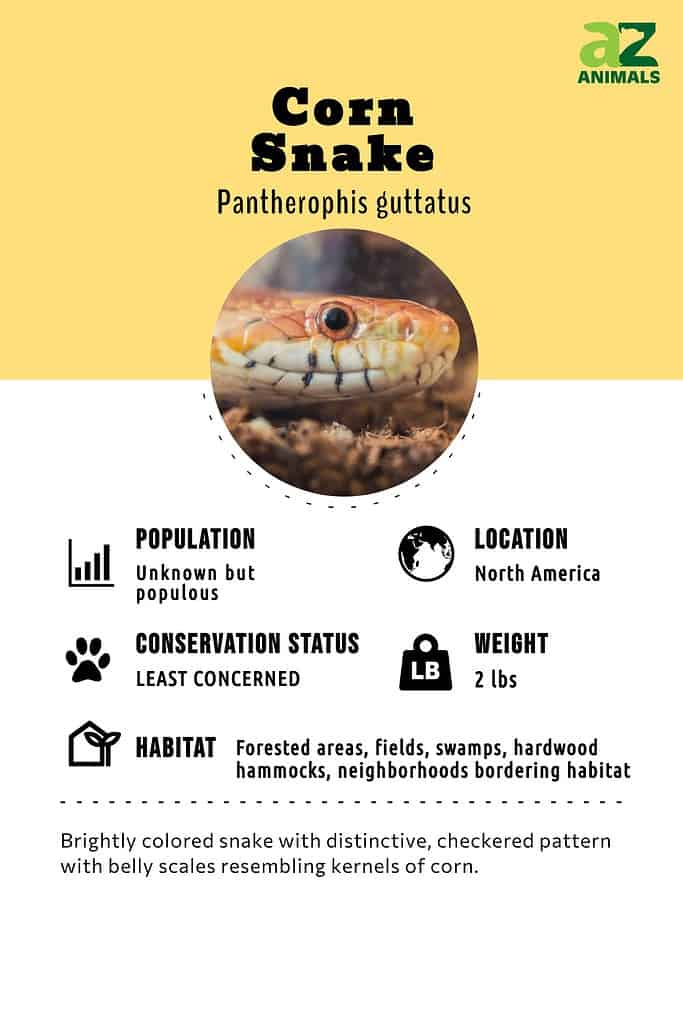
Amazing Facts About Corn Snakes
- Their climbing ability is truly fantastic; their body is perfectly designed for it, and people find them in very odd places. Sometimes even wedging themselves into the grout lines in brick walls to achieve their goals.
- Corn snakes are the most widely bred snake for pets; breeders have created dozens of morphs of different colors.
- Even though they’re partly arboreal, they spend a lot of time underground, prowling through rodent burrows.
Read here to find out more amazing facts about corn snakes.
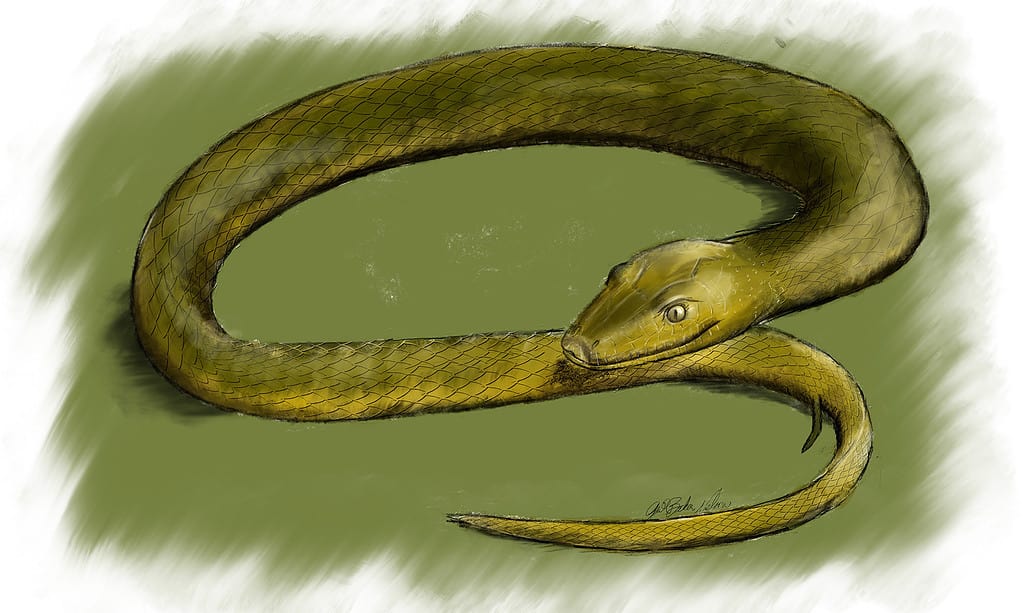
Evolution
Fossil records show that snakes first appeared during the Cretaceous period – although often retained their hind limbs. The earliest true snake fossils come from the marine simoliophiids, the oldest being Hassiophis terasanctus, dated between 112 and 94 million years ago.
Scientists believe that snakes descended from lizards. Pythons and boas, the most primitive snakes, have vestigial hind limbs and some have remnants of a pelvic girdle, appearing as horny projections.
Many modern snakes originated during the Paleocene, alongside the radiation of mammals that occurred after the extinction of non-avian dinosaurs. The expansion of grasslands in North America led to a major radiation of snakes. During the Miocene, the number of snake species increased with the first vipers and elapids and the diversification of Colubridae.
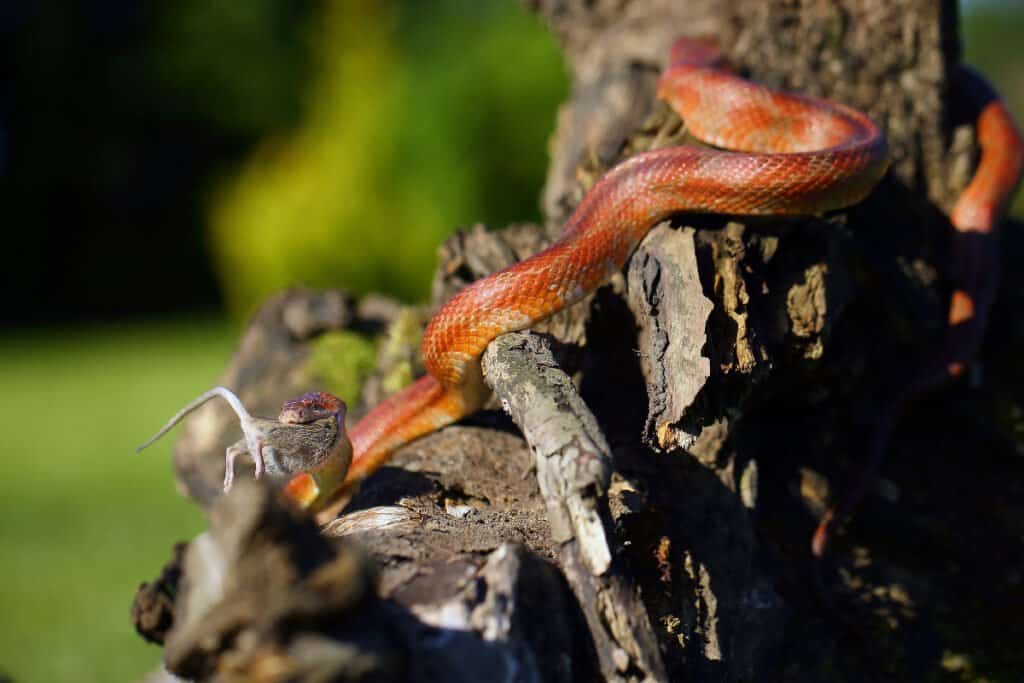
Snakes evolved from lizards and first appear in the fossil record during the Cretaceous period.
©Karel Bartik/Shutterstock.com
Species
The corn snake (P. guttatus) can be split into two or three species (there is dispute) and has been bred into as many as 800 color morphs. The three species are:
- The classic corn snake, (P. guttatus), is found mostly in Florida, the Southeast United States and as far north as New Jersey and Delaware.
- The Great Plains rat snake, (P. emoryi), is found in the central part of the U.S., from Missouri to Nebraska, to Colorado, Texas, and into Mexico.
- Slowinski’s corn snake, (P. slowinskii), is found in western Louisiana and Texas.
Where to Find Corn Snakes
You can find corn snakes throughout most of the southeastern United States. They live in pine woods, swamps, and hardwood hammocks; they’ll also make themselves at home in suburban areas that border favorable habitats.
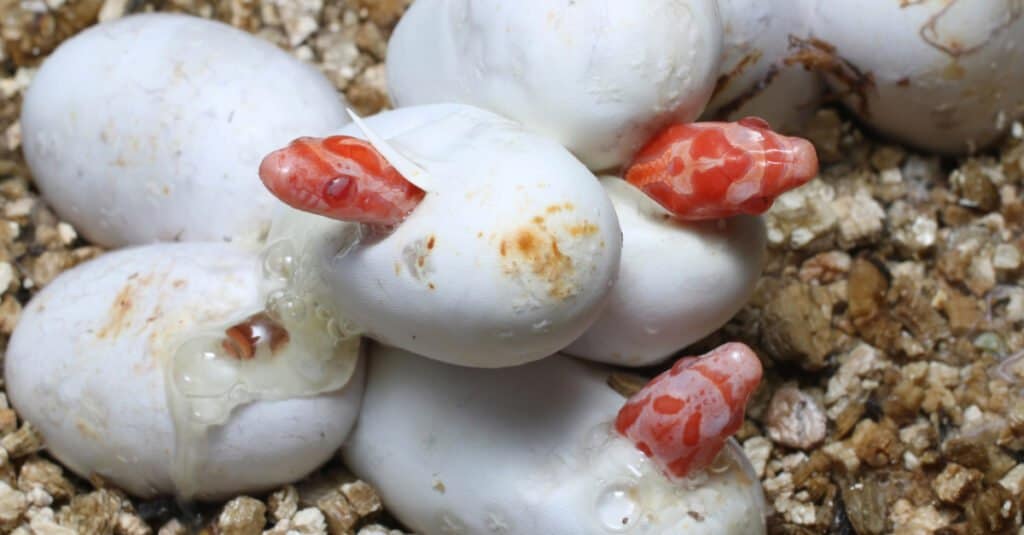
Corn snakes breed in April and May and lay their eggs 4 – 6 weeks later.
©Dan Olsen/Shutterstock.com
They spend their waking hours hunting for small mammals, following them up trees, under houses, and into attics. Many people find that a corn snake (or another rat snake species) found its way into a garage corner, then sat there, rattling its tail, trying to discourage them from approaching.
During cooler weather, they find a safe, isolated place in which to hide until the weather warms. They breed in the spring between April and May and lay their eggs in decaying plant matter about 4-6 weeks after they breed. Hatchlings emerge a couple of months later and measure about 12 inches.
Scientific Name
Likely owing to its colorful pattern, the current genus name, Pantherophis, refers to panthers (panther) and snakes (ophis). These snakes (and many other rat snakes) used to be classified in the genus Elaphe. In the early 2000s, genetic research uncovered new information about rat snakes. Scientists discovered that rat snakes in the Americas are closely related to kingsnakes and moved many species into other genera. They resurrected Pantherophis for use with the North American rat snakes. Most of the North American rat snakes are in the genus Pantherophis now.
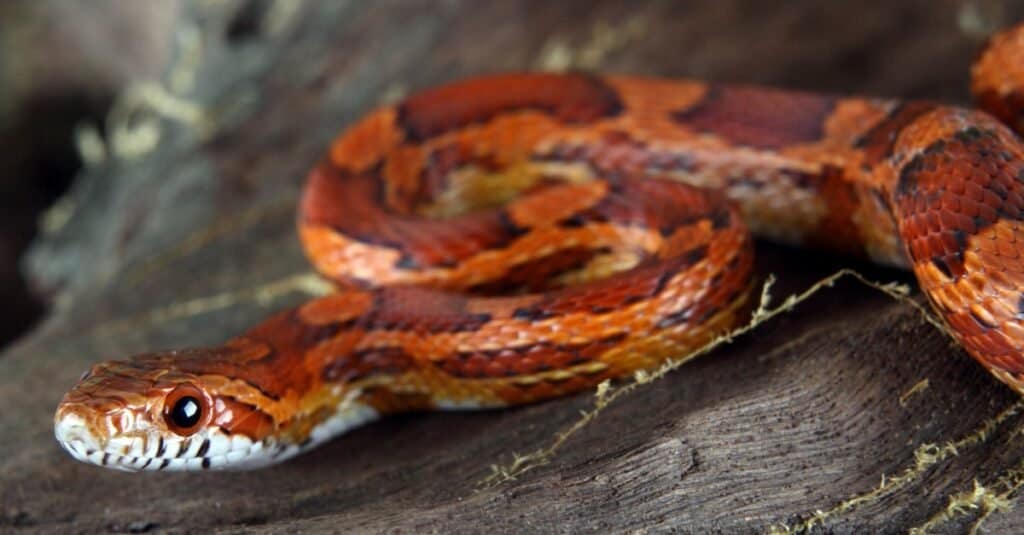
Corn snakes are constrictors, wrapping themselves around prey to squeeze and subdue it before swallowing it whole.
©Enrique Ramos/Shutterstock.com
As far as their common name, some argue that the pattern on its belly inspired its name; after all, the cream-colored ground with darker orange, yellow, or red blotches certainly looks like Indian corn. However, the first known use of corn snake was recorded in 1676, according to the Merriam-Webster Dictionary. This snake tends to hang around the granaries where they stored corn to hunt the mice and rats that ate the corn.
Population and Conservation
According to the IUCN corn snakes aren’t endangered or vulnerable; however, they are the victim of mistaken identity and are killed. Their color confuses people who believe them to be venomous copperhead snakes. The best way to avoid these unfortunate incidents is education and a solid understanding of how to identify venomous and non-venomous snakes. Other (less-dangerous) look likes include the northern mole kingsnake, southern mole kingsnake, and eastern rat snake.
They, like many other rat snake species, have adapted well to the presence of humans, and happily hunt the rats and mice that accompany civilization.
Appearance & Description
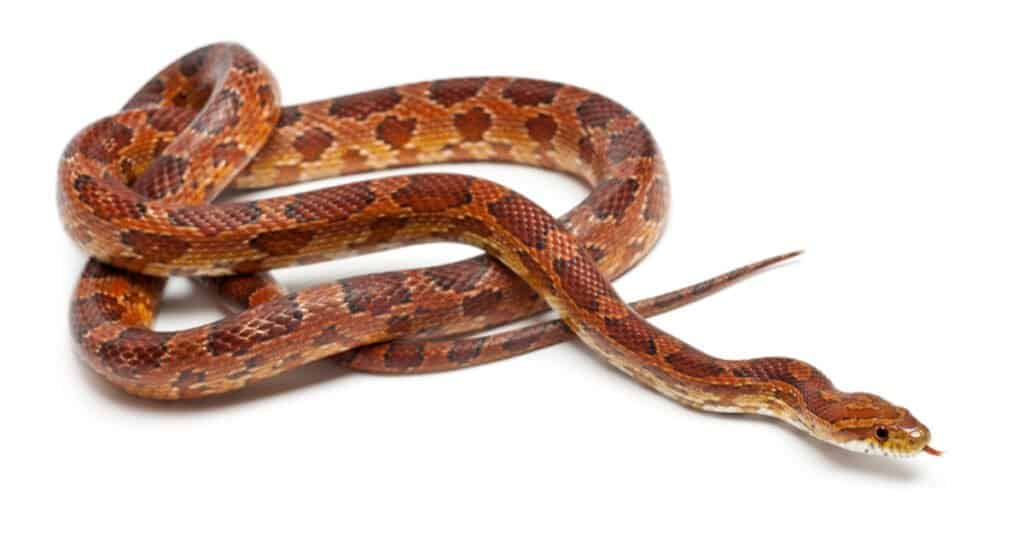
They might have gotten their name from the pattern on their belly scales that looks like maize.
©Eric Isselee/Shutterstock.com
A corn snake is long and slender, sometimes approaching 6 feet in length. The average length is 3-4 feet, but the record length is 6 feet, 2 inches. It is red to orange with black-bordered orange, red, or brown, shield-shaped patterns on its back, matching round blotches on its side, and a spearpoint marking on its head. Its head is sort of turtle-shaped and its eyes often match its coloring and have round pupils. Juveniles begin life more brown-colored than their parents and develop a brighter pattern over time.
Their identification is pretty easy with just the head and body markings; however, people mistake them for venomous copperheads, which inhabit many of the same areas and are killed. Their coloration is similar enough that without taking an extra second it’s sometimes too late for the innocent corn snake.
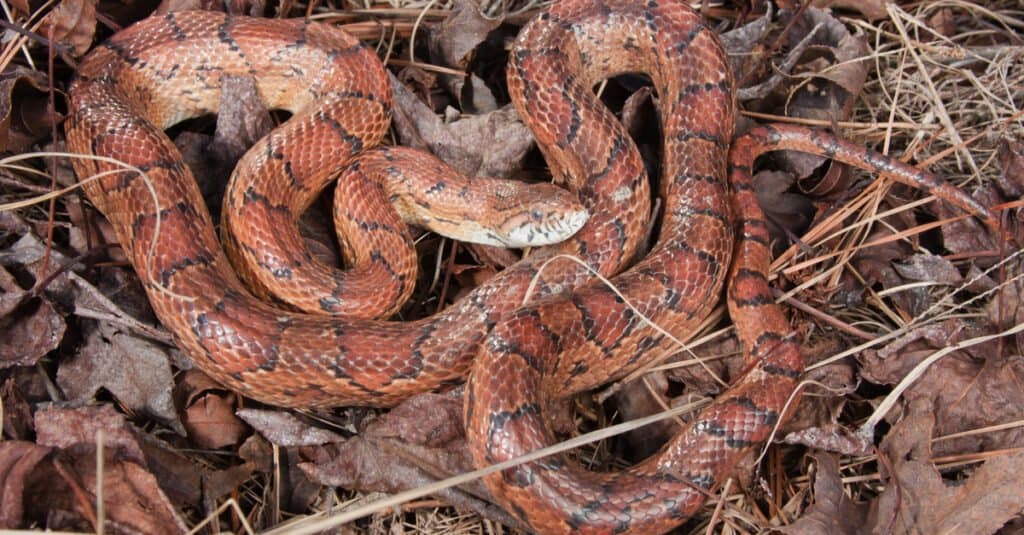
Corn snakes sound like rattlesnakes when they rattle their tails in leaf litter.
©Nathan A Shepard/Shutterstock.com
How Dangerous Are Corn Snakes?
Corn snakes aren’t dangerous at all, they can bite and release a horrible-smelling musk. However, they’re not venomous and don’t have fangs.
These snakes are far more likely to flee than fight, but if they get cornered they put on a good show. Their defensive behavior scares those who don’t know that it’s all a show! If you corner one of these snakes, it will coil up, form an S shape with its head and neck, and strike. It will rattle its tail, and in leaf litter, it sounds like a rattlesnake. It won’t hesitate to bite, but it’s really not aggressive, and the biting is a defense of last resort. This is a snake that’s easy to handle as a pet and calms down fairly quickly once you’re holding it.
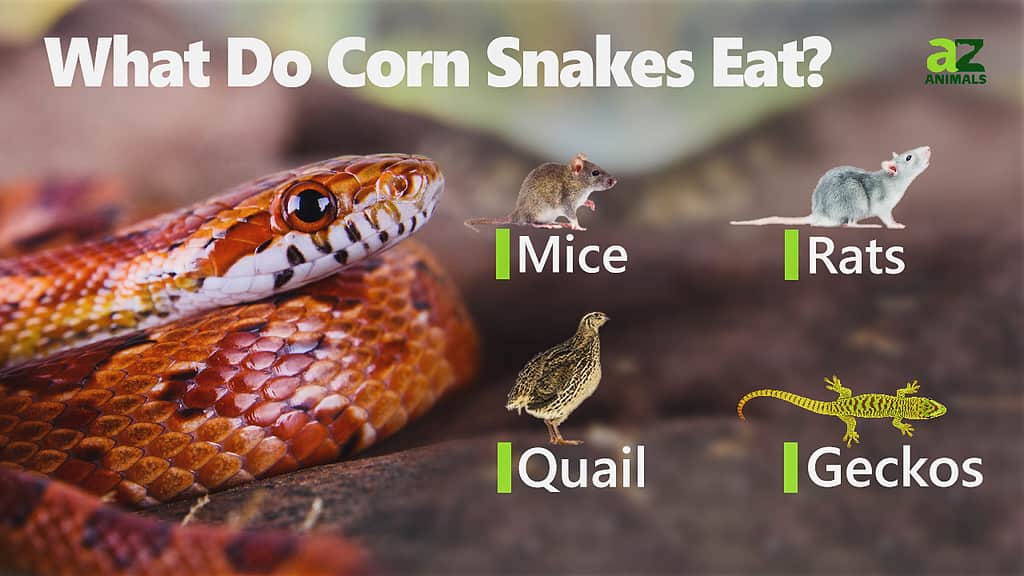
Behavior and Humans
Corn snakes are adaptable and will inhabit wooded areas, woodpiles, meadows, old barns, and abandoned houses. Still, they’re relatively shy snakes and tend to avoid people whenever possible. They take full advantage of the habitats people create around buildings and in yards. If you see a corn snake cruising through your neighborhood, it’s because there are rodents somewhere. Leave it alone to do its job and move along – it will only stay if there is food.
These snakes need to eat every few days, so they’re always slithering about looking for their next meal. Corn snakes are diurnal, but spend a lot of time underground, prowling through rodent burrows. They also hide under leaf litter and old logs.
Corn snakes are constrictors; they grab hold of their prey and quickly coil around and suffocate it; however, they sometimes swallow smaller prey while it’s still alive.
Color Morphs
There are more than 800 recognized corn snake morphs in a variety of incredible colors and patterns. If you’re looking for corn snake morph ideas, make sure to read our ‘Complete Guide to Corn Snake Morphs.’ Whether you’re looking for an albino morph, or one with dark patterns, we have a complete analysis of the most popular morphs and their average costs.
Similar Animals
View all 235 animals that start with CCorn Snake FAQs (Frequently Asked Questions)
Are corn snakes venomous?
These are harmless, non-venomous snakes. They don’t have fangs or venom.
How do corn snakes hunt?
They are active hunters and often prowl through rodent burrows, under buildings, and in trees in search of food.
Are corn snakes aggressive?
Not at all. they try to put on a good show when cornered, but they would rather escape.
Where do corn snakes live?
They live across the southwestern United States, as far north as New Jersey, west to Texas, and south to Florida.
What do corn snakes eat?
Juveniles may eat lizards, but adults prefer warm-blooded prey, such as rats, mice, and birds.
How long do corn snakes live?
The average corn snake lifespan is 6-8 years in the wild. However, in captivity, they can live up to 23 years or more.
What are the differences between a coral snake and a corn snake?
The key difference between the coral snake and corn snake is that the coral snake is venomous, while the corn snake is not.
Read the other differences here!
Thank you for reading! Have some feedback for us? Contact the AZ Animals editorial team.
Sources
- Smithsonian National Zoo / Accessed February 23, 2022
- Reptile Database / Accessed February 23, 2022
- Florida Museum


















